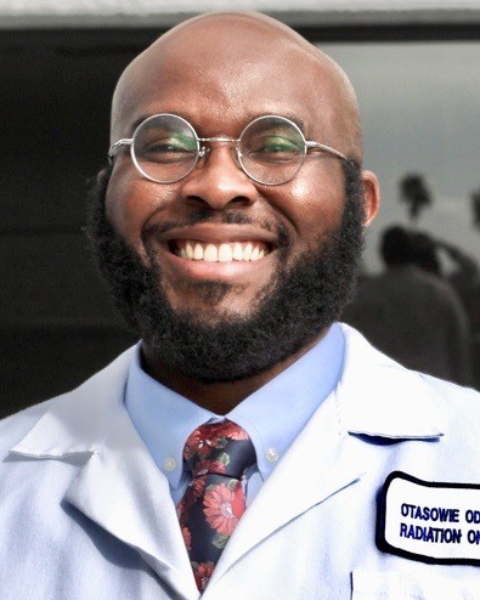PQA 04 - PQA 04 Palliative Care and Central Nervous System Poster Q&A
2583 - Rib Fracture Outcomes in Patients Receiving Lung Stereotactic Body Radiotherapy
Monday, September 30, 2024
10:45 AM - 12:00 PM ET
Location: Hall C
Screen: 34

Otasowie Odiase, MD
Kaiser Permanente Los Angeles Medical Center
Los Angeles, CA
Presenter(s)
O. M. Odiase1, F. Dayani2, J. F. Yao3, J. Rahimian4, and S. Iganej4; 1Kaiser Permanente Southern California Los Angeles Medical Center, Los Angeles, CA, 2Kaiser Permanente Los Angeles Medical Center Residency Program, Los Angeles, CA, 3Kaiser Permanente, Pasadena, CA, 4Southern California Permanente Medical Group, Los Angeles, CA
Purpose/Objective(s): Stereotactic Body Radiotherapy (SBRT) is commonly used in the treatment of metastatic and inoperable lung lesions. Treatment toxicities include chest wall pain and rib fractures. Published dose constraints for rib structures are highly variable, and there is limited data on clinical implications of this variability. Previous studies in the literature evaluating the effects of lung SBRT on rib fractures have small sample size with short follow up. Our study aims to characterize patient and treatment-specific risk factors for rib fracture after lung SBRT. Materials/
Methods: We conducted a retrospective analysis of patient records undergoing lung SBRT at our institution from January 2015 to December 2019. Patient-specific variables included age, gender, race, and stage, while treatment-specific variables included planning target volume (PTV), dose, rib dose, rib volume, anatomic location of lung lesion, post-radiotherapy rib toxicity, and time to development of rib fracture. Additionally, survival outcomes were assessed in our cohort. Descriptive statistics and analysis were carried out on the collected data.
Results: A total of 101 patients met our inclusion criteria. Eleven patients (10.90%) developed rib fracture. Median follow up was 51.00 months (25.70-67.50), and median time to development of an event was 33.33 months (3.00 -69.06 months). The mean rib volume was 24.60cm3 (SD=20.65; Range: 7.60- 78.90) for the fracture group and 85.70cm3 (SD=216.19; Range: 3.00, 1211.50) for the non-fracture group, (p=0.2100). Mean plan tumor volume of patients in the fracture group was 56.00 cm3 (SD= 30.34; Range: 17.10, 106.90) compared to the non-fracture group with a mean of 39.30 cm3 (SD= 29.37; Range: 6.40, 144.60), (p = 0.0373). Additional parameters such as PTV max dose and rib mean/max dose, plan mean dose, and anatomical location did not show statistically significant differences between the two groups. When considering mortality, 72.70% patients were alive and 27.30% died in the fracture group compared to 34.40% alive and 65.60% deceased in the non-fracture group, (p = 0.0206).
Conclusion: The mean plan tumor volume and survival were the two factors that showed a significant difference between the fracture and non-fracture groups. Mean plan tumor volume was significantly higher in the fracture group compared to the non-fracture group, with a comparable range and standard deviation in both groups. Survival outcomes yielded a statistically significant inverse correlation between the two groups. Given the prolonged average time to development of fracture, the direct correlation of overall survival with increased risk of rib fracture suggests that surviving patients are at lifelong risk of developing this toxicity.
Purpose/Objective(s): Stereotactic Body Radiotherapy (SBRT) is commonly used in the treatment of metastatic and inoperable lung lesions. Treatment toxicities include chest wall pain and rib fractures. Published dose constraints for rib structures are highly variable, and there is limited data on clinical implications of this variability. Previous studies in the literature evaluating the effects of lung SBRT on rib fractures have small sample size with short follow up. Our study aims to characterize patient and treatment-specific risk factors for rib fracture after lung SBRT. Materials/
Methods: We conducted a retrospective analysis of patient records undergoing lung SBRT at our institution from January 2015 to December 2019. Patient-specific variables included age, gender, race, and stage, while treatment-specific variables included planning target volume (PTV), dose, rib dose, rib volume, anatomic location of lung lesion, post-radiotherapy rib toxicity, and time to development of rib fracture. Additionally, survival outcomes were assessed in our cohort. Descriptive statistics and analysis were carried out on the collected data.
Results: A total of 101 patients met our inclusion criteria. Eleven patients (10.90%) developed rib fracture. Median follow up was 51.00 months (25.70-67.50), and median time to development of an event was 33.33 months (3.00 -69.06 months). The mean rib volume was 24.60cm3 (SD=20.65; Range: 7.60- 78.90) for the fracture group and 85.70cm3 (SD=216.19; Range: 3.00, 1211.50) for the non-fracture group, (p=0.2100). Mean plan tumor volume of patients in the fracture group was 56.00 cm3 (SD= 30.34; Range: 17.10, 106.90) compared to the non-fracture group with a mean of 39.30 cm3 (SD= 29.37; Range: 6.40, 144.60), (p = 0.0373). Additional parameters such as PTV max dose and rib mean/max dose, plan mean dose, and anatomical location did not show statistically significant differences between the two groups. When considering mortality, 72.70% patients were alive and 27.30% died in the fracture group compared to 34.40% alive and 65.60% deceased in the non-fracture group, (p = 0.0206).
Conclusion: The mean plan tumor volume and survival were the two factors that showed a significant difference between the fracture and non-fracture groups. Mean plan tumor volume was significantly higher in the fracture group compared to the non-fracture group, with a comparable range and standard deviation in both groups. Survival outcomes yielded a statistically significant inverse correlation between the two groups. Given the prolonged average time to development of fracture, the direct correlation of overall survival with increased risk of rib fracture suggests that surviving patients are at lifelong risk of developing this toxicity.
